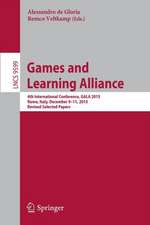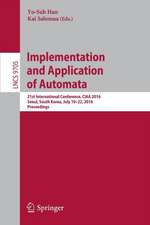Anthropology-Based Computing: Putting the Human in Human-Computer Interaction: Human–Computer Interaction Series
Autor John N.A. Brownen Limba Engleză Hardback – 25 mar 2016
This three-part guide argues that human interest and calm technology need to be at the heart of HCI. It begins by exposing the inherent dangers in past and present HCI. Using his past experiences within Anthropology, Linguistics, Education, Ergonomics, Human Factors, and Computer Science the author introduces and explores the theory of ‘Anthropology-Based Computing’ (ABC) as well as a new ideas like Dynamic Environmental Focus (DEF), a new model ofGeneral Human Interaction (GHI), and a new triune model of the brain: Brown’s Representation of Anthropogenic Interaction in Natural Settings (BRAINS). Detailed illustrations show how HCI can be improved by considering how human bodies and brains actually work. The final part is a series of simple illustrated experiments, each applying an aspect of ABC to improve the way our computers and computerized devices treat us.
Anthropology-Based Computing is written for those who work with computers, not just those who work on them. Students and researchers in Design and Psychology, and Computer Scientists as well, will benefit from seeing what is missing from the devices that are already in place, why that is, and how to make the practical changes that will immediately improve the physiological and psychological experience of using phones, on-board navigation systems, and the countless other computers we use at work and at home today and will continue to use in the future.
| Toate formatele și edițiile | Preț | Express |
|---|---|---|
| Paperback (1) | 331.25 lei 6-8 săpt. | |
| Springer International Publishing – 19 apr 2018 | 331.25 lei 6-8 săpt. | |
| Hardback (1) | 337.52 lei 6-8 săpt. | |
| Springer International Publishing – 25 mar 2016 | 337.52 lei 6-8 săpt. |
Din seria Human–Computer Interaction Series
- 20%
 Preț: 655.85 lei
Preț: 655.85 lei - 20%
 Preț: 309.25 lei
Preț: 309.25 lei - 20%
 Preț: 375.54 lei
Preț: 375.54 lei - 20%
 Preț: 644.48 lei
Preț: 644.48 lei - 20%
 Preț: 667.75 lei
Preț: 667.75 lei - 20%
 Preț: 664.44 lei
Preț: 664.44 lei - 20%
 Preț: 1164.84 lei
Preț: 1164.84 lei - 20%
 Preț: 817.55 lei
Preț: 817.55 lei - 20%
 Preț: 657.16 lei
Preț: 657.16 lei - 20%
 Preț: 645.31 lei
Preț: 645.31 lei - 20%
 Preț: 938.66 lei
Preț: 938.66 lei - 15%
 Preț: 658.05 lei
Preț: 658.05 lei - 20%
 Preț: 822.51 lei
Preț: 822.51 lei - 20%
 Preț: 654.21 lei
Preț: 654.21 lei - 20%
 Preț: 994.26 lei
Preț: 994.26 lei - 20%
 Preț: 1621.89 lei
Preț: 1621.89 lei - 20%
 Preț: 991.60 lei
Preț: 991.60 lei - 20%
 Preț: 783.45 lei
Preț: 783.45 lei - 20%
 Preț: 1175.42 lei
Preț: 1175.42 lei - 20%
 Preț: 659.97 lei
Preț: 659.97 lei - 20%
 Preț: 219.15 lei
Preț: 219.15 lei - 20%
 Preț: 334.86 lei
Preț: 334.86 lei - 20%
 Preț: 969.84 lei
Preț: 969.84 lei - 20%
 Preț: 642.19 lei
Preț: 642.19 lei - 20%
 Preț: 314.39 lei
Preț: 314.39 lei - 20%
 Preț: 661.14 lei
Preț: 661.14 lei - 20%
 Preț: 995.89 lei
Preț: 995.89 lei - 20%
 Preț: 752.58 lei
Preț: 752.58 lei - 20%
 Preț: 990.30 lei
Preț: 990.30 lei - 20%
 Preț: 990.12 lei
Preț: 990.12 lei - 20%
 Preț: 336.21 lei
Preț: 336.21 lei - 20%
 Preț: 334.71 lei
Preț: 334.71 lei - 20%
 Preț: 312.62 lei
Preț: 312.62 lei - 20%
 Preț: 994.92 lei
Preț: 994.92 lei - 20%
 Preț: 331.74 lei
Preț: 331.74 lei - 20%
 Preț: 646.80 lei
Preț: 646.80 lei - 20%
 Preț: 334.86 lei
Preț: 334.86 lei - 20%
 Preț: 994.40 lei
Preț: 994.40 lei - 20%
 Preț: 329.76 lei
Preț: 329.76 lei - 20%
 Preț: 332.24 lei
Preț: 332.24 lei - 20%
 Preț: 992.11 lei
Preț: 992.11 lei - 20%
 Preț: 650.40 lei
Preț: 650.40 lei - 20%
 Preț: 337.00 lei
Preț: 337.00 lei - 20%
 Preț: 332.39 lei
Preț: 332.39 lei - 20%
 Preț: 1279.86 lei
Preț: 1279.86 lei - 15%
 Preț: 636.12 lei
Preț: 636.12 lei - 20%
 Preț: 336.67 lei
Preț: 336.67 lei - 20%
 Preț: 1000.70 lei
Preț: 1000.70 lei - 20%
 Preț: 645.14 lei
Preț: 645.14 lei
Preț: 337.52 lei
Preț vechi: 421.90 lei
-20% Nou
Puncte Express: 506
Preț estimativ în valută:
64.58€ • 67.61$ • 53.44£
64.58€ • 67.61$ • 53.44£
Carte tipărită la comandă
Livrare economică 05-19 aprilie
Preluare comenzi: 021 569.72.76
Specificații
ISBN-13: 9783319244198
ISBN-10: 3319244191
Pagini: 245
Ilustrații: XXVII, 243 p. 94 illus., 35 illus. in color.
Dimensiuni: 155 x 235 x 20 mm
Greutate: 0.56 kg
Ediția:1st ed. 2016
Editura: Springer International Publishing
Colecția Springer
Seria Human–Computer Interaction Series
Locul publicării:Cham, Switzerland
ISBN-10: 3319244191
Pagini: 245
Ilustrații: XXVII, 243 p. 94 illus., 35 illus. in color.
Dimensiuni: 155 x 235 x 20 mm
Greutate: 0.56 kg
Ediția:1st ed. 2016
Editura: Springer International Publishing
Colecția Springer
Seria Human–Computer Interaction Series
Locul publicării:Cham, Switzerland
Public țintă
GraduateCuprins
Foreword.- Preface.- Introduction.- Part I: Everything You Wanted to Know About the Evolution of Computerized Technology, But Where Afraid to Ask.- You are Here.- How Computing Became Ubiquitous and What That Means.- Getting Excited About Calm Technology.- The Evolution of Humans and Technology Part 1 – Humans.- The Evolution of Humans and Technology Part 2 – Technology.- The Evolution of Humans and Technology Part 3 – Computers.- What are Human Factors and Why Should We Care?.- Ergonomics and Biomechanics: The Surprising Science of Using your Body.- Psychology and Neurology: The Surprisingly simple Science of Using your Brain. Part II: Taking Control – It’s as Easy as A,B,C.- The Theory of Anthropology-Based Computing.- The Early Days of Anthropology-Based Computing.- The Future of Anthropology-Based Computing.- Part III: Citizen Science: Simple Solutions to Improve the Way Your Technology Treats You.- Stop your Mouse from Twisting Your Arm.- Stop your Keyboard from Twisting Your Arm.- Stop your Tech From Wringing Your Neck, Breaking Your Back, and Being an All-Round Pain In Your… Life.- Stop Your Phone from Screaming at You (and Everyone Else!).- Stop your Messages from Killing You ( or Your Friends, or Total Strangers).- Stop Your Dashboard Navigator from Driving You to Distraction.- Stop your Noise-Blocking, High Volume Headlines from Stopping Your Ears.- Your Chapter, an Invitation.- Afterword.
Recenzii
“The book is a great resource to not only introduce the subject from a historical perspective, but also to expose readers to the subject supported by experience-based examples analogous to the HCI environment. … The abstract and summary in each chapter provide the desired focus and help the reader glean the most important information. … the book will generate interest from researchers pursuing HCI who are involved in experimentation.” (Harekrishna Misra, Computing Reviews, April, 2017)
Notă biografică
John N. A. Brown is an inventor and researcher who has lived and lectured on four continents as a specialist in Human Factors and Human-Computer Interaction. Dr Brown is trying to advance Weiser and Brown's concept of Calm Technology and hoping to bring a few new practices and a few new tools into common use, based on the concepts that a) the real world is much more complex than any computer or software ever invented, and b) it has taken us a very long time to evolve and adapt to the world in a way that allows us to be both effective and comfortable. In short, Mr. Brown proposes that it is time to start designing our most ubiquitous tools to better suit our natural human abilities and limitations and calls this approach Anthropology-Based Computing.
Textul de pe ultima copertă
We have always built tools to improve our productivity and help us lead better lives; however we find ourselves constantly battling against our new computerized tools, making us less productive and putting our health and our lives at risk. This book looks at Human-Computer Interaction (HCI) from a truly human-centred perspective; focusing on human physiology and psychology rather than the motley series of brilliant innovations, glorified mistakes, and cross-generational habits that comprise the computer-centred HCI that we practice today.
This three-part guide argues that human interest and calm technology need to be at the heart of HCI. It begins by exposing the inherent dangers in past and present HCI. Using his past experiences within Anthropology, Linguistics, Education, Ergonomics, Human Factors, and Computer Science the author introduces and explores the theory of ‘Anthropology-Based Computing’ (ABC) as well as a new ideas like Dynamic Environmental Focus (DEF), anew model of General Human Interaction (GHI), and a new triune model of the brain: Brown’s Representation of Anthropogenic Interaction in Natural Settings (BRAINS). Detailed illustrations show how HCI can be improved by considering how human bodies and brains actually work. The final part is a series of simple illustrated experiments, each applying an aspect of ABC to improve the way our computers and computerized devices treat us.
Anthropology-Based Computing is written for those who work with computers, not just those who work on them. Students and researchers in Design and Psychology, and Computer Scientists as well, will benefit from seeing what is missing from the devices that are already in place, why that is, and how to make the practical changes that will immediately improve the physiological and psychological experience of using phones, on-board navigation systems, and the countless other computers we use at work and at home today and will continue touse in the future.
This three-part guide argues that human interest and calm technology need to be at the heart of HCI. It begins by exposing the inherent dangers in past and present HCI. Using his past experiences within Anthropology, Linguistics, Education, Ergonomics, Human Factors, and Computer Science the author introduces and explores the theory of ‘Anthropology-Based Computing’ (ABC) as well as a new ideas like Dynamic Environmental Focus (DEF), anew model of General Human Interaction (GHI), and a new triune model of the brain: Brown’s Representation of Anthropogenic Interaction in Natural Settings (BRAINS). Detailed illustrations show how HCI can be improved by considering how human bodies and brains actually work. The final part is a series of simple illustrated experiments, each applying an aspect of ABC to improve the way our computers and computerized devices treat us.
Anthropology-Based Computing is written for those who work with computers, not just those who work on them. Students and researchers in Design and Psychology, and Computer Scientists as well, will benefit from seeing what is missing from the devices that are already in place, why that is, and how to make the practical changes that will immediately improve the physiological and psychological experience of using phones, on-board navigation systems, and the countless other computers we use at work and at home today and will continue touse in the future.
Caracteristici
Introduces Anthropology-Based Computing (ABC), a new model for natural human interaction with our tools, computers and our increasingly computerized environment Provides straightforward, illustrated advice on how to apply human physiology and psychology to designing or modifying an interface or tool so that it can be truly human-centred Contains practical tutorials aimed at making our computer devices less disruptive to our daily lives; like how to stop instant messages from distracting you while driving






















